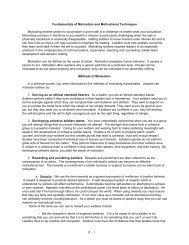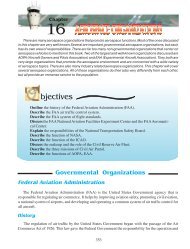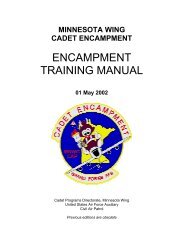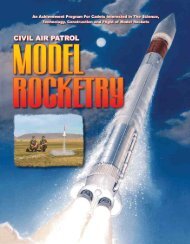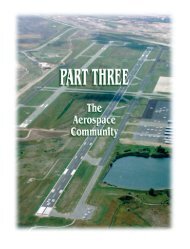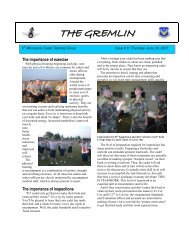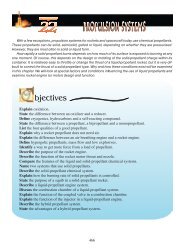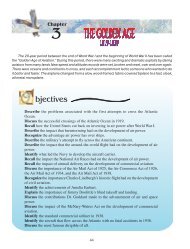the resources – setting the direction of your company?• Would different members of your management teampaint different pictures of what the company should be inthe near and distant future?• Is your statement of future strategy more helpful forpublic relations purposes than as a clear guide for futureproducts and markets?The more of these questions you answered “yes,” themore your company’s strategy is in trouble. If you answeredall “yes,” then you can probably hold last rites forstrategy in your organization. It is officially dead.HOW STRATEGIC THINKING CAN SURVIVEStrategic thinking has long been considered an intellectualnicety; it has provided a patina of respectability tocorporate statements built solely on operations considerations.Management attention, however, has been givenmainly to operational planning and decisions, for it ishere that the “big payoff” could be pursued. In addition,without a process, managers have tended to shy awayfrom the high risks inherent in strategic thinking. Theypreferred instead to dwell in the lower risk, more securearea of long-range planning. But, in today’s world, eventhe best operations planning and decisions are not enough.We can no longer afford the “security” of avoiding highrisk strategic discussions. What, then, can be done?Strategic thinking must be separated from long-rangeplanning and must precede it. Preaching separation ofstrategy and long-range planning may appear platitudinous,but most organizations tend to confuse the two.One major corporation, for example, has this patchworkquilt of overall objectives:…to market and produce legitimate products and servicesat quality levels in their respective markets…toutilize resources fully in order to maximize return onstockholders’ investment…to structure the Companyand assign responsibility in ways that promote efficiencyand incentive, and reward achievement…toprovide satisfying, healthful, long-term employmentat all levels…to maintain through fluctuating businesscycles the confidence of customers, employees, andstockholders…to preserve the integrity of the companyin its accounting and reporting procedures, andthereby, the confidence of the investing public.The first two objectives above say something, howevervague, about what the company wants to be in termsof products, markets, and return. But the remaining objectivesare operations; they are how-to oriented guidelinesfor the operation of the business. By maskingstrategic considerations with operational ones, the abovecompany is headed for an identity crisis as it is pushedand pulled into the future with no clearly defined pictureof itself.Besides making strategic considerations usable,another advantage of separating strategic thinking fromoperations thinking is that it simplifies the long-rangeplanning process. Strategic thinking and long-range planningin most instances should not cover the same timeperspective. A clear, specific statement of strategy coveringthe next five years generally diminishes the need toproject long-range plans over the same time frame. Wehave found that organizations with clear strategies canput their planning focus on shorter-range plans. Once astrategy is formulated and key areas identified, detailedlong-range planning can be limited to these areas.There is a tendency to feel that because long-rangeplanning covers a longer time span than short-range planning,it is strategic. Conversely, there is a tendency to feelthat the short range is not strategic, but operational. Boththe operational and the strategic, however, can have eitherimmediate or long-range time significance. Strategy is afunction of direction, not time. Operations are a functionof how this direction is achieved, not time.Separating strategic from operational thinking alsodiminishes any controversy over the merits of “top down”versus “bottom up” planning. Both approaches areneeded; it is just a matter of where and when. Strategymust be set at the top.If top management has a unique responsibility, it is todetermine the future nature and direction of the organization.Given this strategic framework, the long and shortrangeoperational planning must be done at all levels inthe organization where the needed information exists.If middle and lower levels of management have oneunique responsibility, it should be to plan their operationsto support the overall direction of the organization.Once separated from the operational, strategic thinkingcan survive only if it is clear, specific, and simple. Onlythen can it provide a framework in which long-rangeplanning and day-to-day decision making can proceed.And only in this way can the executive intelligently assesswhich products and markets should be emphasized,which should be de-emphasized or abandoned, and whatthe scope of new products and markets should be. But notmany companies have such a framework.When companies do have a simple statement of corporatestrategy, their statements tend to be so general thatthey are relatively useless as guidelines for specific futureproduct/market choices. Consider this summary statementof corporate strategy:Our business is the creation of machines or methodsto help find solutions to the increasingly complexproblems of businesses, government, science, spaceexploration, education, medicine, and nearly everyarea of human endeavor.30
Could you establish new market and product prioritiesbased on this?THE “DRIVING FORCE”: KEY <strong>TO</strong> STRATEGYThe key to developing a simple, clear, and usefulstatement of strategy lies in the concept of the “drivingforce.” Our research has identified nine strategic areasthat impact and influence the nature and direction of anyorganization. These nine areas can be grouped into threebasic categories:CategoryStrategic Areas1. Products/markets: Products offeredMarket needs2. Capabilities: TechnologyProduction capabilityMethod of saleMethod of distributionNatural resources3. Results: Size/growthReturn/profitIn every one of the 75 major organizations with whichwe have worked, we have found that one of the abovenine areas can be identified as the driving force – thestrategic area that is the primary determinant of the organization’sproducts and markets. The driving force alsodetermines the requirements of the organization’s otherstrategic areas.The following examples, taken from observations ofthe product and market actions of companies in variousindustries, further illustrate the concept of the drivingforce.1. Products offered. The organization with products offeredas its driving force will continue to produce productssimilar to those it has. New products will tend to bevery similar to current products, and the organizationwill seek new markets where there is a need for its existingproduct line. Its capabilities will be directed towardthe support of its basic products. For example, researchand engineering would be devoted to product improvementsrather than to the development of different kindsof products. The actions of the major automobile companiessuggest that their driving force is “products offered.”2. Market needs. The organization whose driving forceis market needs determine its products or services fromneeds in the markets or market segments it serves. Thisorganization will constantly look for new and differentproducts to fill these market needs. It will also search fornew or emerging needs in these markets. While its capabilitiesare directed to the support of its current marketsand products, it is perfectly willing to acquire very differentcapabilities to introduce new kinds of products. Theactions of major consumer products companies, such asProcter & Gamble, suggest that their driving force is“market needs.”3. Production capability. An organization is driven byproduction capability when it offers products or servicesthat can be performed using its production know-how,equipment, and processes. Looking for economies ofscale, it will focus on efficiencies in production, and anynew products will utilize the same production know-how,equipment, and processes that produced the originalproducts. The actions of commodity-based companies,such as many of those in the paper industry, suggest thattheir driving force is (or was) “production capability.”4. Return/profit. An organization driven byreturn/profit will have very specific return/profit targetsthat may be quite different from its current level of performance.These targets are the basis for developing oracquiring future products and/or markets. Such a drivingforce will frequently lead this organization into very differentand unrelated products or markets as a means ofachieving these return/profit objectives over time. Theactions of certain conglomerates, such as ITT WorldCommunications, suggest that their driving force is“return/profit.”On first thought many top managers see return/profitas their driving force because profit is equated with survivaland is the key measure of continued success. Thusall companies have profit objectives by which to measureoperations. Profit, however, is a driving force only if it isthe primary determinant of the kinds of future productsand markets that characterize an organization. But this isthe case in very few companies.There is no implication in the above examples thatthe driving force remains fixed. Changes in externalevents or the desires of top management can change anorganization’s driving force. A typical pattern of change isfrom “products offered” to “market needs.” For example,this pattern is true for many of the consumer goods andservices companies, such as Procter & Gamble, Gillette,Playboy Enterprises, and Merrill Lynch, Pierce, Fenner &Smith.Another common pattern is to shift from “productioncapability” to “products offered,” a change that has characterizedsuch companies as Kimberly-Clark and InternationalMultifoods (formerly International MillingCompany).Four key reasons explain why the concept of drivingforce is critical to setting strategy:• The essential nature of an organization is reflected inits products or services, the markets or customers it services,its capabilities to support these products and markets,and its growth and return. The driving force is the31
- Page 1 and 2: VOLUME FOUR STRATEGIC PERSPECTIVESL
- Page 3 and 4: VOLUME FOUR STRATEGIC PERSPECTIVESL
- Page 5 and 6: VOLUME FOUR STRATEGIC PERSPECTIVESL
- Page 7: VOLUME FOUR STRATEGIC PERSPECTIVESL
- Page 10 and 11: 12CHAPTER 12INTRODUCTION TO STRATEG
- Page 12 and 13: 12.1 Strategic Leadership: Defining
- Page 14 and 15: mandates or resolutions that would
- Page 16 and 17: and ambiguity, aspiring strategic l
- Page 18 and 19: 12.2 National Security StrategyThe
- Page 20 and 21: within our borders has always been
- Page 22 and 23: front common challenges like violen
- Page 24 and 25: and our strategy, not sector earmar
- Page 26 and 27: thinking about organizations. She m
- Page 28 and 29: A systemic approach to failure is m
- Page 30 and 31: The late W. T. Grant Company is a r
- Page 34 and 35: focal point for describing and inte
- Page 36 and 37: Consequently, we do not restrict th
- Page 38 and 39: paragraphs, Web pages, then edit an
- Page 40 and 41: Web, can be viewed as a CS attempt
- Page 42 and 43: How to evaluate users and contribut
- Page 44 and 45: 13CHAPTER 13LEADING PUBLIC &VOLUNTE
- Page 46 and 47: 13.1 Leadership for Volunteers:The
- Page 48 and 49: 13.2 Take Root: Volunteer Managemen
- Page 50 and 51: QualificationsClearly list educatio
- Page 52 and 53: and effectively track their volunte
- Page 54 and 55: • Understand rules for recognitio
- Page 56 and 57: • Send a birthday card.• Submit
- Page 58 and 59: and tested more than six decades af
- Page 60 and 61: specific interests of the donors, v
- Page 62 and 63: tain) tax-exempt status from the In
- Page 64 and 65: Smucker, 1999).The Internal Revenue
- Page 66 and 67: culture is necessary to ensure the
- Page 68 and 69: 13.4 The New Look of TransparencyBy
- Page 70 and 71: ees for a couple of reasons: One, i
- Page 72 and 73: 13.5 Public and Private Management:
- Page 74 and 75: TABLE 1:FUNCTIONS OF GENERAL MANAGE
- Page 76 and 77: 3. Career System. The model corpora
- Page 78 and 79: islative charter - the Clean Air Ac
- Page 80 and 81: In controlling performance, Chapin
- Page 82 and 83:
14CHAPTER 14AIRPOWER ASSTRATEGIC LA
- Page 84 and 85:
14.1 Strategic Air Power: Fulfillme
- Page 86 and 87:
carry it out. Their daylight raids
- Page 88 and 89:
you did not rely on strategic bombi
- Page 90 and 91:
14.2 Warden and the Air Corps Tacti
- Page 92 and 93:
ecomes one of applying sufficient i
- Page 94 and 95:
tification, and a Jominian claim to
- Page 96 and 97:
courage the rapid and widespread ex
- Page 98 and 99:
it to influence physical players in
- Page 100 and 101:
14.4 Basic Air Force DoctrineAF Doc
- Page 102 and 103:
earthquake-stricken Haiti. The worl
- Page 104 and 105:
perspective. Airmen do not divide u
- Page 106 and 107:
Command and ControlCommand and cont
- Page 108 and 109:
14.5 Should the US Maintain the Nuc
- Page 110 and 111:
form of human government.” 20 Dem
- Page 112 and 113:
obtainable goal. See the Global Zer
- Page 114 and 115:
15CHAPTER 15ORGANIZATIONAL CULTURE
- Page 116 and 117:
15.1 Organizational CultureBy Doria
- Page 118 and 119:
Review. This action strives to unco
- Page 120 and 121:
gram will serve and then having the
- Page 122 and 123:
ticipating the changes being made b
- Page 124 and 125:
Many years of working with change p
- Page 126 and 127:
At the least, the areas of concern
- Page 128 and 129:
15.4 Developing an Innovative Cultu
- Page 130 and 131:
CONCLUDING THOUGHTSIn an ever-chang
- Page 132 and 133:
global issues. Businesses that poss
- Page 134 and 135:
— Sees the big picture—the shif
- Page 136 and 137:
16CHAPTER 16STRATEGIC COMMUNICATION
- Page 138 and 139:
16.1 Principles of Strategic Commun
- Page 140 and 141:
16.2 The Art of NegotiationBy Brend
- Page 142 and 143:
16.3 Negotiating Effectively Across
- Page 144 and 145:
hidden areas can act as cultural ho
- Page 146 and 147:
and four conflict styles. Hammer be
- Page 148 and 149:
maintaining the relationship. As th
- Page 150 and 151:
25 Mitchell R. Hammer, “Chapter 1
- Page 152 and 153:
tural, socioeconomic, and psycholog
- Page 154 and 155:
for the win-win," during which time
- Page 156 and 157:
interests and, at worst, as a gun s
- Page 158 and 159:
Public diplomacy is surely about mu
- Page 160 and 161:
But public diplomats do not have th
- Page 162 and 163:
Photo courtesy of the familyThe LEA
- Page 164:
THE CADET OATHI pledge that I will



